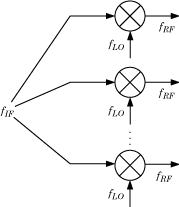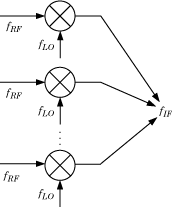Set up an OpenIF object as a multiband receiver, add three mixers to it, and obtain information about its spur-free zones.
Define an OpenIF object. The first input is the bandwidth of the IF signal (50 MHz). The 'IFLocation','MixerOutput' name-value pair specifies a down-converting configuration.
The following figure shows the down-converting configuration.
Define the first mixer with an intermodulation table and add it to the OpenIF object. Mixer 1 has a RF center frequency at 2.4 GHz, has a RF bandwidth of 100 MHz, and uses low-side injection.
Mixer 2 has an RF center frequency at 3.7 GHz, has a bandwidth of 150 MHz, and uses low-side injection.
Mixer 3 has an RF center frequency at 5 GHz, has a bandwidth of 200 MHz, and uses low-side injection.
The multiband receiver is fully defined and ready for spur-free-zone analysis. Use the report method to analyze and display spur and spur-free zone information at the command line. The method also returns information about the mixers in the receiver.
Intermediate Frequency (IF) Planner
IF Location: MixerOutput
-- MIXER 1 --
RF Center Frequency: 2.4 GHz
RF Bandwidth: 100 MHz
IF Bandwidth: 50 MHz
MixerType: low
Intermodulation Table: 99 0 21 17 26
11 0 29 29 63
60 48 70 65 41
90 89 74 68 87
99 99 95 99 99
-- MIXER 2 --
RF Center Frequency: 3.7 GHz
RF Bandwidth: 150 MHz
IF Bandwidth: 50 MHz
MixerType: low
Intermodulation Table: 99 0 9 12 15
20 0 26 31 48
55 70 51 70 53
85 90 60 70 94
96 95 94 93 92
-- MIXER 3 --
RF Center Frequency: 5 GHz
RF Bandwidth: 200 MHz
IF Bandwidth: 50 MHz
MixerType: low
Intermodulation Table: 99 0 15 23 36
10 0 34 27 59
67 61 56 59 68
97 82 81 60 77
99 99 99 99 96
Spur-Free Zones:
5.00 - 6.25 MHz
6.25 - 8.33 MHz
8.33 - 465.00 MHz
495.00 - 581.25 MHz
618.75 - 720.00 MHz
760.00 - 775.00 MHz
825.00 - 900.00 MHz
1.03 - 1.16 GHz
1.28 - 1.41 GHz
1.52 - 1.56 GHz
1.71 - 1.76 GHz
2.04 - 2.17 GHz
2.27 - 2.33 GHz
2.56 - 2.71 GHz
3.07 - 3.12 GHz
3.44 - 3.51 GHz
3.83 - 3.91 GHz
4.09 - 4.35 GHz
5.29 - 5.43 GHz
5.73 - 5.79 GHz
6.81 - 6.86 GHz
7.66 - 7.84 GHz
8.82 - 9.05 GHz
10.23 - 10.85 GHz
11.35 - 11.43 GHz
13.61 - 14.08 GHz
15.33 - 18.10 GHz
18.90 - 19.58 GHz
20.43 - 21.73 GHz
22.68 - 24.48 GHz
Use the show method to analyze the receiver and produce an interactive spur graph. Generating a spur graph is a convenient way to summarize the results of the analysis graphically.



